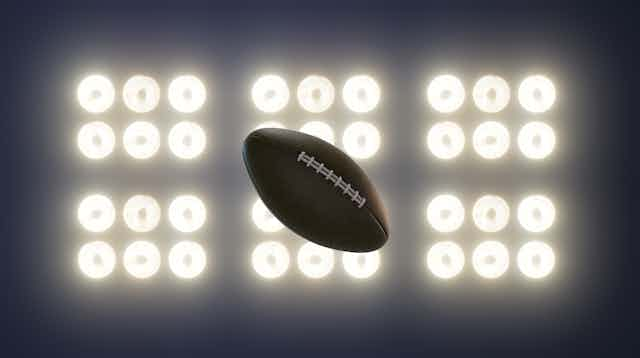With the Kansas City Chiefs and the San Francisco 49ers set to face off in the 2024 Super Bowl, another conversation now begins in earnest about the TV commercials that will run during one of the most-watched television events of the year. And while some of the usual suspects will once again advertise on-air to the more than 110 million viewers watching the game in the U.S., other regulars will be noticeably absent.
As professors who study marketing and business ethics, we’re keenly interested in Super Bowl advertising. So we looked at the roster of advertisers in search of trends.
The most interesting thing we found may be who’s not advertising. Gone are the Big Four automakers – Ford, General Motors, Chrysler parent Stellantis and Toyota – which have chosen to dedicate their ad dollars to more tightly targeted marketing campaigns. Only Kia and BMW are stepping up to promote their new electric vehicles, while Volkswagen has advertising lined up to celebrate its 75th anniversary in the U.S.
Also missing this year will be GoDaddy, whose Super Bowl ads have generated buzz over the years. Its management has indicated that the company is exploring other marketing options that create more engagement for their target markets.
Advertisers seeking a touchdown
Super Bowl ads this year, which sold out by early November 2023, are dominated by food and beverage brands. These products appeal to a broad target audience. First-time advertisers like Popeyes, Drumstick, Nerds, and Pepsi’s new lemon lime soda, Starry, will join perennial advertisers Reese’s, M&M’s, Pringles, Frito-Lay and Mountain Dew, among others.
The world’s largest brewer, Anheuser-Busch InBev, plans to run multiple ads across its various brands, including recently tarnished Bud Light, hoping to add to its history of producing iconic Super Bowl commercials.
At a cost of up to US$7 million for a 30-second spot – the same as last year – this brief stint on the big stage doesn’t come cheap. And that’s before taking into account the cost to create the ads themselves, often more than twice what they will spend to run them on game day. All together, one spot can cost companies more than $20 million.
What are these advertisers hoping to gain, and is it worth it? For some, it clearly can be.
To start, consider that the most effective ads – those that stand out above the crowd – are visible long before the game begins and for weeks and even years afterward. Teasers, trailers and sometimes the full ads themselves are typically released in the weeks prior to the Super Bowl and reviewed on TV, online and across social media.
That coverage also continues after the game, with polls and feature stories ranking which ads worked and which didn’t as Monday morning advertising quarterbacks weigh in. Some of the best Super Bowl ads even take on a life of their own that lasts long after they first ran. Who can forget the iconic 1980 Coca-Cola commercial featuring Pittsburgh’s Mean Joe Greene tossing a young fan his jersey? While the ad originally aired in late 1979, it reached a much broader audience during the game a few months later.
That ad has remained so popular that it was remade as a commercial for Coke Zero 30 years later featuring fellow Steelers player Troy Polamalu. Pre- and post-Super Bowl coverage in recent years often revives them both, as well as other iconic ads – decades later.
The TV tide is turning — a little
So why are the Big Four automakers, GoDaddy and other former Super Bowl advertisers forsaking the big game? Gen Z, in particular, is not impressed by Super Bowl ads, and complicating the matter is their lack of interest in broadcast TV.
Marketers know TikTok and other social sites are better platforms for delivering messages to targeted demographics. The return on investment for advertising is far easier to track in these venues, and the ad spend is easier to justify – especially considering how often these ads will be shared with family and friends in a matter of seconds with just a few keystrokes.
Still, in today’s fractured media landscape, the Super Bowl is a rare event with truly mass appeal: More than 60% of Americans tuned into last year’s game, according to the NFL. That’s a lot of eyeballs.
In the end, today’s marketing executives recognize that Super Bowl TV commercials work best when they promote mass market products – through humor, use of animals, nostalgia and celebrities – as well as social causes that resonate with consumers. Linking a brand with memorable and creative storytelling is also an effective way to boost overall brand visibility.
That’s the formula for success in this year’s Super Bowl.


